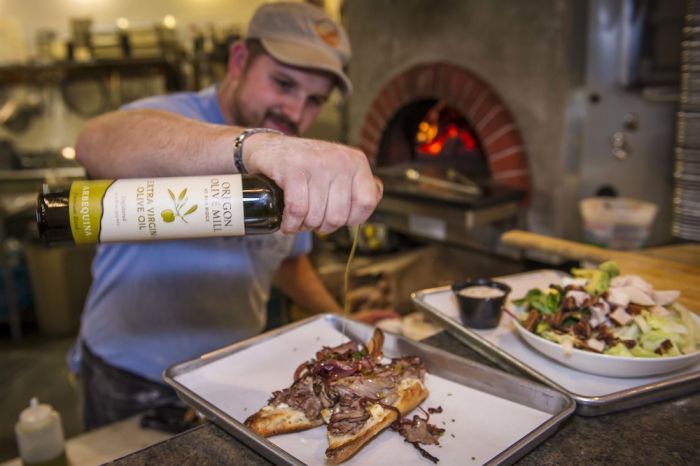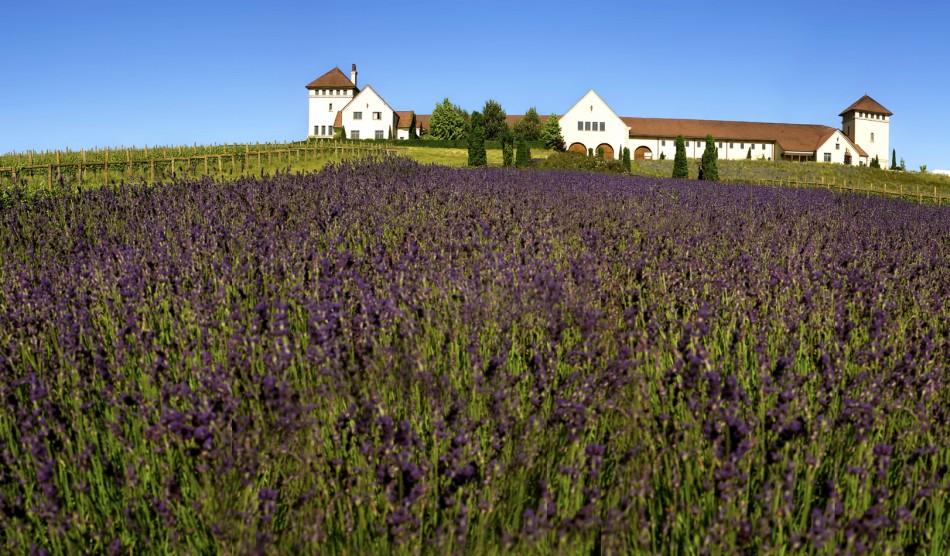The trees at the Oregon Olive Mill in Dayton, Oregon are young and spindly when olive farmer and miller Paul Durant takes a midsummer walk through his orchards. Yet, these young trees are showing signs of progress that excite Durant.
“Typically around this time of year, we could see where the flower was and also see that it was falling off,” he observes. “This year, we’re seeing that more than half of the flowers are pollinated and starting to plump up. That suggests that we’ve done a much better job on the nutrient load of these trees and that we’ll have a really nice run of fruit this year.” In warm climates such as Spain and Italy, farmers have been growing olives and pressing oil for 6,000 years. Oregon’s olive industry, however, is just getting underway.
It has taken Durant and his parents, Ken and Penny Durant, eight years to get to this point. They know that new challenges lie in the years ahead. In their years spent working in the orchards and at the mill, however, they’ve learned how to refine their farming techniques, increase their fruit yields and give a risky venture a fighting chance.
In the 1970s, Ken and Penny were among the first farmers to try planting wine grapes in the Willamette Valley. So, when Ken decided to plant olive trees on the family’s hillside property in 2005, he was prepared to deal with skeptics. “We planted grapes in 1973, and we had neighbors telling us we couldn’t raise wine grapes in Oregon,” says Ken. “Today, we are working on the same premise with olives, and we obviously have made a heavy commitment to making it work.”
At the outset, the family ran tree trials with everything from the Spanish Arbequinas to Greek Koroneiki to determine the best varietals for their property. Today, they mainly grow the Tuscan and French varietals that have proven more adaptable to Oregon’s cold, wet weather.
In 2008, the Durants bought a small Italian-made mill and began milling oil on site. “I’m an advocate that you can’t learn to swim in the shallow end,” says Ken. “Once we made the decision to grow olives and we had trees that were producing them, we pulled the trigger and put in a state-of-the-art mill. It’s probably the smallest commercial mill you can buy, but we’ve learned to run it smartly.”
Drawing from his engineering background, the younger Durant became the miller and began learning the production side of the olive oil industry. Over the years, he has developed a milling style that yields oils with a spicy, pungent flavor. Those signature oils have earned him praise—and business—from a handful of local chefs.
“It is beautifully made oil, really delicious and fruity,” says Red Hills Market chef and owner, Jody Kropf. “We prepare things in the Italian style at the market, so we use Paul’s olive oil all over our menu. We make a house vinaigrette and marinated olives with it, and use it for everything from caramelizing onions to roasting vegetables to finishing hot sandwiches and pizzas.”
The flavor and quality of Durant’s olive oil are the main reasons chefs like Kropf use it. The local food movement is also compelling. “We focus on using local products, and also on interacting with our neighbors and friends,” says Kropf. “I love that when we run out of oil, Paul just drives it down and drops it off.”
Currently, the family harvests olives from 2,500 of their 13,000 trees, which has not been enough to keep up with demand. Durant augments his crop with olives brought in from family farmers in Northern California. He produces blended oils that have included anywhere from 5 to 12 percent olives from his orchard. When the trees reach maturity in five to seven years, the family plans to produce oils made from their entirely estate-grown fruit.
Until the Durants can grow enough of their own olives, they recognize that producing blends is the best way to hone their growing, harvesting and milling techniques. Their supporters agree. “We need to invest in Oregon olive oil now by buying it and helping these guys get better at their job,” says Aaron Adams, chef and co-owner of Portland’s Portobello, a vegan trattoria. ”We need to support them and show them that there is a market for it.”
Vitaly Paley of Paley’s Place is the sole chef purchasing 100 percent Oregon olive oil from the mill—albeit in limited quantities. The Portland chef asked Durant to make him an estate olive oil years ago, but it wasn’t until 2011 that Durant had enough local fruit to fulfill that request. Last spring, Paley began using this oil for dipping bread and for finishing charcuterie.
“It’s unbelievable oil, and the flavor is incredibly intense,” says Paley. “There certainly isn’t enough sun here to make it so rich and tasty, so it has to be something Paul is doing in the pressing to make it taste this way,”
At times, the Durants are just in awe of their product and the project they began years ago. “Periodically I wander around this property, and I wonder if we really did this,” says Ken. “Where else can you get Oregon-made olive oil?”
All photos by Andréa Johnson.
Feeling inspired? Try some of these recipes featuring Oregon-made olive oil.








